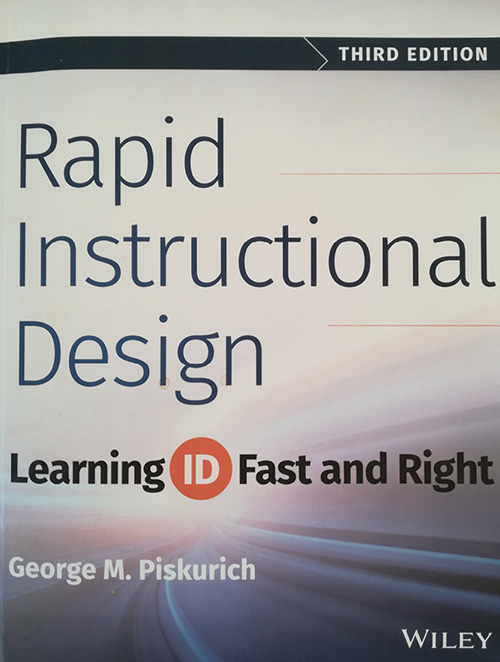Book Reviews

Rapid Instructional Design: Learning ID Fast and Right, Third Edition
by George M. Piskurich
Hoboken, New Jersey: John Wiley & Sons, Inc., 2015
560 pages, $77.95
ISBN: ISBN-13: 978-1118973974
For more information on accessing this file, please visit our help page.
Reviewed by James Cantafio
An experienced presenter, author, and leader in instructional design, George M. Piskurich has much to offer in his book, Rapid Instructional Design: Learning ID Fast and Right, Third Edition. Having presented at over thirty conferences and symposia, Piskurich has established a reputation based upon the mastery of proven methods of teaching and effective learning techniques. With emphasis placed upon the importance of strong instructional design to achieve desired learning outcomes, Piskurich is the de facto modern day expert when it comes to explaining the theory and action behind the analysis, design, development, implementation and evaluation of instructional courses and programmes. In this keystone book on the subject of instructional design practice, Piskurich presents a fresh look at the systematic process associated with producing quality, effective, and efficient training and education.
Each of the 11 chapters in this 560 page paperback book reflects and aligns with the internationally-recognized model associated with a systems approach to producing training and education. Commonly known as ADDIE, the Analysis, Design, Development, Implementation, and Evaluation model serves as accepted standard framework for instructional design. While the ADDIE approach and process of instructional design has essentially remained core to effective instructional systems design or ISD, the author argues that what has changed over time is the need to deliver quality training and education sooner. More than ever, there is the need for instructors and organizations to produce learning results faster. Without focusing too much upon background theory, Piskurich shows the reader how to produce quality, effective, and efficient training and education solutions. Emphasis is centered upon meeting student and institutional goals by concentrating on those key elements of instructional design that are deemed critical for learning success.
This book is very practical and informative. Well organized, it serves both the novice and advanced instructional designer in a number of different ways. First, by focusing on process, outcomes, and performance over theory and discourse; the author provides simple, easy to use, and practical checklists. For example, there are checklists for learning evaluation, training cost estimates, and simplified training plan templates. These checklists can be further adapted to reflect different learning requirements. Second, the book does not have to be read sequentially. Each chapter stands well on its own. When reading alternate chapters, context is not lost in appreciating the importance and relevance of instructional design from a systems perspective. Focus is therefore placed upon the immediate need; be it the design of a lesson plan, or the development of new deliverables, such as in class or online courses. Third, a number of lessons learned and best practices have been integrated throughout the book. Field tips, hints, shortcuts, and additional notes serve to share experience throughout the book, while applying context to the valuable tools, checklists, and templates presented. Finally, a comprehensive glossary presents a complete list of modern training and development related terms. Such terms and constructs are considered essential towards understanding, situating, and explaining instructional systems design requirements.
Piskurich stresses the importance of strong instructional design to the learning process. This is clearly articulated through a solid collection of proven best practice, repeated lessons learned, and critical approach to stress the importance of strong instructional design in the learning process. Each chapter shows that regardless of changes in learning technologies, new approaches to teaching, or advances in testing methodology; adhesion to tried-and-true, time-tested principles of good instructional design ultimately count when it comes to creating effective learning. In other words, instructional design is, and remains, key to learning.
Although it has been five years since its publication, this book continues to have strong relevance towards advancing military training and education, including within the Canadian military context. Training and education within the Canadian Armed Forces (CAF) is, and continues to be, based upon the ADDIE model. Known within the CAF as the Canadian Forces Training and Education System (CFITES), these principles and guidelines remain fundamental in the effective analysis, design, development, conduct, evaluation and validation of training and education programmes for the CAF. It is by adhering to the principles and practice associated the ADDIE model that CFITES continues to be as relevant today, as it was over twenty years ago. In essence, strong instructional design remains paramount to learning success. This book serves as an excellent resource for both the CAF instructional designer and instructional staff.
Lieutenant-Commander James Cantafio is a senior Training Development Officer and Human Resources Manager, currently working at Canadian Army Headquarters G1 Personnel Policy. Semper viam meliorem quaerentes. (Always seeking a better way: Motto of the Training Development Officers Branch).







